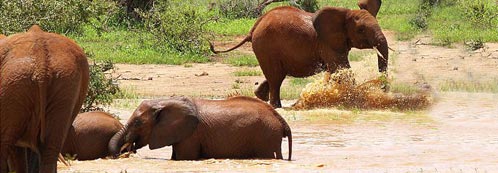Field Notes
January - April 2015
Between January and March it was hot and humid and it rained in some areas of the park. Then in mid-April the rains were widespread and all the waterholes filled. Carmine Bee-eaters, Eurasian Rollers, Harriers, Barn Swallow, Herons and Egrets were in the bull area from January through March. While I was waiting for a group of bulls to emerge from a thick bush area, four Egrets perched on my vehicle roof rack and several Carmine Bee-eaters landed on Zebras while they were resting in the sun.
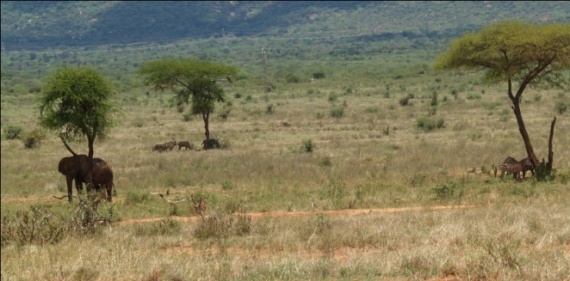
Different species frequently feed, travel and drink from a waterhole together. But when they move to a shady tree, the species separate. A group of Fringe-eared Oryx, Zebra and Darwin were relatively close while drinking at a waterhole and as the temperature increased they moved to the shade. Photo: Darwin left, Oryx, left and Zebra on the right, all resting in the shade under their respective trees.
World Wildlife Day was in March. To commemorate the day Kenya burned 15 tons of elephant tusks at Nairobi National Park.
Bulls
With the atypical rainfall pattern and changes in the state of the vegetation, it was difficult to predict where bulls would be located. Some days I found just one or two, while other days I found several including Darwin, Livingstone, Arrow, Sunray and Sandstone.
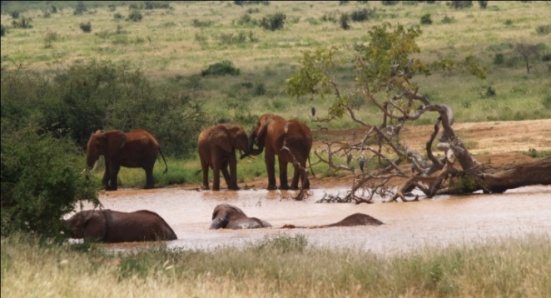
In mid-January Skylight was in musth, alone feeding in the bull area. He had broken off half of his right tusk. Two-hours later he moved to a waterhole and joined a bull group, Zigzag, Crux, Zero and two unknown bulls, splashing and swimming (photo Skylight center under water). Although he was in musth he was not aggressive toward the other bulls. Four days later Skylight was still in musth, feeding alone near the road. After I recorded his sighting data, I waited for him to move away from the road so I could drive forward. When I turned on the engine he turned quickly in my direction and moved to the road shaking his head. As I drove forward he followed me dragging his trunk along my tire tracks and shaking his head. I expected him to turn and move into the bush but he followed me for 4km. Finally he moved off the road into the bush to a waterhole. Ten days later he was not in musth, drinking at a waterhole with a 20 year old bull. They moved from the waterhole, with Skylight in the lead, to a shady tree to rest. Skylight suddenly raised his head and moved quickly away from the tree - a lioness was walking through the tall grass. He stopped when the lioness stopped and moved toward her when she moved away. The other wildlife watched Skylight and the lioness until she crossed the road and moved into some thick bush,
Families
In February Eldora's family was at a waterhole drinking and splashing. They stayed at the waterhole for 20 minutes a typical amount of time for Tsavo families to spend at a waterhole. In contrast, Tsavo bulls stay at a waterhole for 1-3 hours, often sleeping in the center of the pool. In early-March Savanna's family and Summer's family were together with a young male 12-14 years old, feeding at the base of a hill. Both of their youngest female offspring, born in September & October of last year, were healthy. Then in early April Summer's family was alone and two weeks after that Savanna's family was alone.
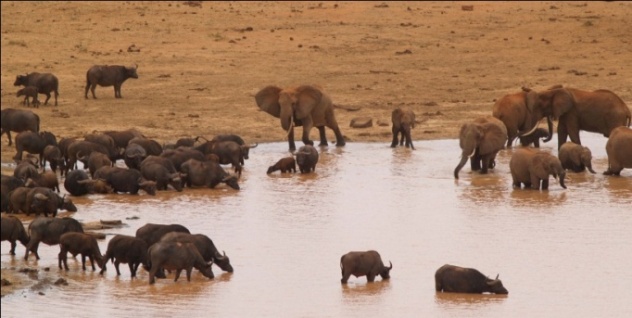
In March, Chrystal's family was 27km from the last sighting. Not a great distance for a Tsavo family to travel but in an unexpected area. She was with several families and a 20 year old bull in a group of 19. Her 2½ year old male calf stayed close to her when a large herd of buffalo arrived at the waterhole. With Chrystal's family was an adult female with a male newborn (1-2 days old). At this age a newborn tends to move among all the elephants in a group and often the mother directs the movements of her newborn with her trunk. This newborn was no exception; he wanted to follow the bull. Each time the bull moved away the newborn followed, the bull then stopped and using his back leg, gently pushed him away and when that didn't deter the newborn he turned and lowered his head but the newborn just moved toward his head. Meanwhile the mother was close by, following her calf but not intervening. But, when the bull stepped back and trumpeted the mother quickly moved forward and using her trunk pulled her newborn close to her. When the bull moved toward the waterhole to drink, this time the newborn did not follow, but stayed next to his mother.
May - August 2015
With heavy April rains most of the waterholes were full and the vegetation was green. In May, there were aggregations of 300 and 400 elephants in the southern area of the park. It became quite difficult to concentrate on identification features when there was so much happening; trumpeting, rumbling, young bulls sparring, bulls chasing females and mating. I stopped collecting data and just watched all the activity. The temperature dropped considerably in July and August and there were frequent showers during both months. Not enough to fill waterholes but enough so that in some areas the vegetation began to produce new shoots. But the new green grass and shrubs lasted for only a week before drying-up again.
In June a lioness and three young lions were walking across an open grassland area to a small hill. One of the young lions was carrying an elephant dung “ball”. When she got to the top of the hill, she dropped it and watched it roll down, and then she ran down and pounced on it, picked it up again and walked back to the top of the hill. She did this three times while her mother and siblings watched. On the fourth roll she let the ball roll away, down the hill into the tall grass.
Bulls
In early-May Rasputin was in musth, alone. In late-May Nathan was in musth with a family. Then in mid-June I saw Nathan, alone, still in musth, walking from the south headed to an open glade. As I was watching Nathan, Rasputin, in musth, with a family, passed behind me headed to the same glade as Nathan. When they all met in the glade, Nathan, older than Rasputin, flapped his ears and Rasputin backed away. In the three hours of observation Rasputin watched Nathan but there was no aggression between the two musth bulls. In late-June Rasputin was alone, still in musth at the same open glade. Four hours later a family of eight joined him.
In May, Arrow and Cobalt were walking along an elephant path headed to a waterhole in the bull area. Cobalt was in front and when he stopped Arrow pushed him and he moved forward again. As they got close to the waterhole they both stopped, raised their trunk and Cobalt moved back and behind Arrow; a lioness was resting under a tree at the waterhole. They stayed close together to drink, on the opposite side of the waterhole from the lion. Arrow moved toward the tree, where the lion was resting but she didn't move, but when he rumbled and tossed his trunk she got up and quickly trotted to the other side of the waterhole. Now that the way was clear, they moved to the tree to scratch and then rest.
Sadly, there is a high probability that Darwin, a bull I've known for 25 years, has died.
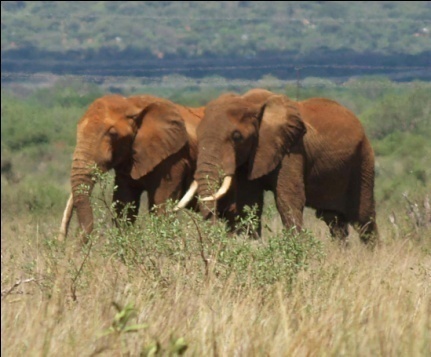
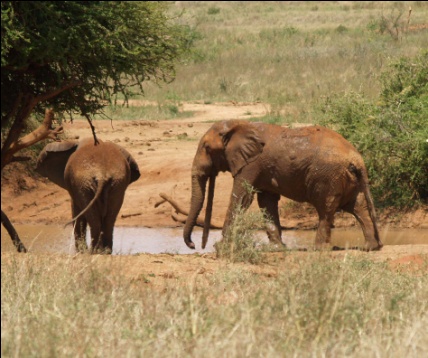
On the 30th of January, he was in a thick bush area with 11 bulls including Sun, Cloud, Sandstone, Sunray, Wishbone and Cobalt. On the 7th of April, he was with Chance (photos). On both occasions he appeared healthy. Then in June, a report of a large bull with a single right tusk, possibly Darwin, was found dead (cause-unknown) in the bull area. However, the single tusk was broken and short, so maybe it wasn't him. When I went to the site, the bones were scattered over a large area. The skull did have a large hole in the top-left side, matching the indentation in Darwin's forehead. Although it probably was Darwin, since I didn't see the body intact I can't confirm identification, so I still have some hope that he is alive.
Families
In early-May Tiberia's family moved south near Voi River, 30 km from the last sighting in February. Between May and August, Savanna's family and Summer's family were together on several occasions, but on other occasions the families were separated. Both of their female offspring born late-last year were healthy.
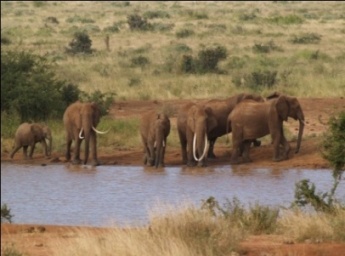
In early-May Chrystal's family moved south near Voi River, the region she spends most of her time in. They were 47 km from the last sighting in March, not a great distance for a Tsavo family to travel.
In mid-May Eldora's family was near Voi River, a distance of 37 km from the last sighting in February. The in June the family moved to the western area. For four months there was an addition to Eldora's family, a young female, with a hole in the middle of her right ear (photo: Skye-left; Eldora-center; new female-right). She was originally sighted in 2014 with Tiberia's family. But, then in late-August she was not with Eldora's family.
September - December 2015
In September most of the vegetation and natural waterholes were dry. In mid-October, rain in some areas was heavy and many waterholes filled. Several Steepe Eagles arrived with the early rains in October. Then in mid-November the expected El Nino arrived with heavy and wide-spread rains. Large flocks of Barn Swallows and many Eurasian Rollers, Pallid and Montague Harriers arrived in the bull area. There was more rain in December and all of the waterholes were overflowing creating small lakes.
Bulls
Bulls were in small groups of three-four bulls in September and October, but in November and December many of them were alone, with one other bull or with families. Often right after the rains elephants begin to dig-up and eat tubers and soil for salts and mineral. 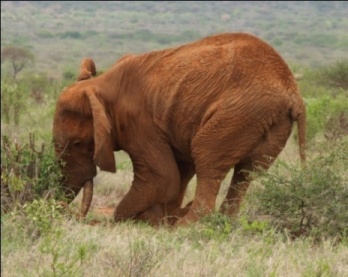 In October with the early rains, Moon, photo right, was digging-up a tuber. First he used his front foot to remove the soil around the base of a shrub to uncover a tuber. Then he blew air around the tuber to remove the soil and bent down and using his trunk and tusks as leverage was able to dig up the tuber. In late-December, Moon was in musth, first alone, feeding in a thick bush habitat. Then he decided to head to a waterhole, where a young bull (20 years old) was resting under a nearby tree. When he approached this bull he folded his ears, then backed away and turned to the waterhole. As he was mud-wallowing, a younger bull (15 years old) joined the group. Both young bulls watched Moon, until he got out of the waterhole and followed him to a tree to scratch then rest
In October with the early rains, Moon, photo right, was digging-up a tuber. First he used his front foot to remove the soil around the base of a shrub to uncover a tuber. Then he blew air around the tuber to remove the soil and bent down and using his trunk and tusks as leverage was able to dig up the tuber. In late-December, Moon was in musth, first alone, feeding in a thick bush habitat. Then he decided to head to a waterhole, where a young bull (20 years old) was resting under a nearby tree. When he approached this bull he folded his ears, then backed away and turned to the waterhole. As he was mud-wallowing, a younger bull (15 years old) joined the group. Both young bulls watched Moon, until he got out of the waterhole and followed him to a tree to scratch then rest
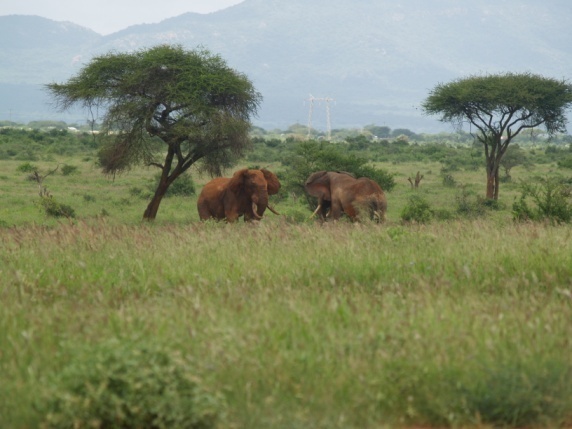
Meanwhile Sun (40-45 years old) also in musth, came from the south heading toward the waterhole. He got a quick drink then continued north, when he suddenly stopped raised his trunk with ears open then veered in the direction of Moon's group. When he approached Moon he folded his ears then stopped. Moon responded in the same way, and then they lunged toward each other (photo left). Sun backup a few steps and then Moon charged. Sun quickly turned and ran with Moon chasing him, right toward me. I turned on the engine and quickly turned around to get out of their way. Sun ran past me into a thick bush area. Although Sun is older than Moon and both bulls were in musth Moon was dominant.
Also in late-December Skylight was in musth, alone drinking from a waterhole. Then he headed toward the base of a hill, stopped, opened his ears and listened then moved forward following a zigzag pattern through the bush; following the trail of an estrus female. Also in late-December Livingstone was in musth, guarding a young female in a family of 11 heading north along an elephant trail at the base of a hill. He stayed close to the young female and when a young bull approached them, Livingstone rumbled, flapped his ears and the bull backed away.
Families
Eldora's family was alone in August in a thick bush area headed toward an open grassland habitat. Summer's family was also alone in early August but then two weeks later, and for the next two months Summer's family and Savanna's family were together. Then in early October Savanna's family was alone again.
In September Lyris's family, a family I have not seen in a year, were travelling across an open grassland headed toward a tree to rest. Then in November Angelica's family, another family I have not seen for several years, was in the same area headed north. Tiberia's family spent most of October and November near the hills in the northwest. They spend most of their time in the western area around the hills and open grassland habitat. But on occasions they move south to the river. Tiberia is the family matriarch, often leading the family to and from a waterhole and feeding through the bush.
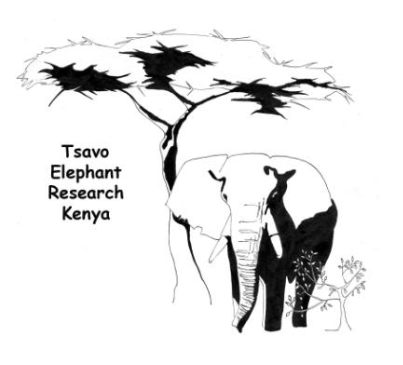
Tsavo Elephant Research Needs Your Help.
Donations are needed to continue this 30+ year field study
and support a Kenyan research field team.
We monitor the behaviors of Tsavo known bulls and families:
group dynamics, offspring & survival, musth cycles and habitat use.
Please click here or on the donate button
to send your donation.
Thank you!
Barbara
